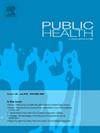Prevalence and predisposing factors of digital game addiction and cyberbullying in adolescents: A cross-sectional study
IF 3.9
3区 医学
Q1 PUBLIC, ENVIRONMENTAL & OCCUPATIONAL HEALTH
引用次数: 0
Abstract
Objectives
This research was conducted to measure the prevalence of digital game addiction and cyberbullying and their predisposing factors among adolescents.
Study design
A cross-sectional design.
Methods
The sample consisted of 1002 adolescents (the mean age was 15.77 (SD = 1.08), and 95.1 % boys) from a vocational high school. Data were collected through a questionnaire, the Digital Game Addiction Scale, and the Revised Cyberbullying Inventory-II. Associations were analyzed with multiple logistic regression analyses.
Results
The prevalence of digital game addiction was 41.5 %. The risk of digital game addiction was higher among adolescents who were cyberbullies (2.3 times), those who played games for 4 h or more (5.1 times), and those who played action/adventure (1.4 Times) and sci-fi games (1.5 times). The risk of cyberbullying was higher in adolescents who were addicted to digital games (2.3 times) or used the Internet for 5 h or more (2.2 times). Meeting on the Internet (2 times) and being a 9th-grader (2 times) compared to 10th and 11th-graders increased the risk of being a cyberbully.
Conclusions
The study concluded that about half of the adolescents were addicted to digital games, and the majority of them were cyberbullies. Common predisposing factor for digital game addiction and cyberbullying was found to be time spent on the Internet.
求助全文
约1分钟内获得全文
求助全文
来源期刊

Public Health
医学-公共卫生、环境卫生与职业卫生
CiteScore
7.60
自引率
0.00%
发文量
280
审稿时长
37 days
期刊介绍:
Public Health is an international, multidisciplinary peer-reviewed journal. It publishes original papers, reviews and short reports on all aspects of the science, philosophy, and practice of public health.
 求助内容:
求助内容: 应助结果提醒方式:
应助结果提醒方式:


